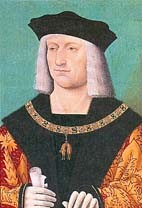Order of the Golden Fleece under Maximilian I (1477–1486)
Under the reign of the splendorous dukes of Burgundy Phillip the Good and Charles the Bold the Order of the Golden Fleece turned into one of the most magnificent monarchical orders of knighthood of the 15th century. The assemblies, ceremonials, rituals and constitution were highly regarded in Europe and were taken as an example for other elitist associations. In 1477, caused by his marriage with the only heiress Mary, the later Roman-German King and Emperor Maximilian I of Austria not only took over the duchy of Burgundy, which was weakened by inner and outer attacks, but also the sovereignty of the Order of the Golden Fleece. His work and his relation concerning the order between 1477 and 1486 are documented in the records of the order. The edition and analysis of these records are the matter of this research project.
The records report about the inauguration of the order’s new sovereign, of two assemblies (held in Bruges in 1478 and in Hertogenbosch in 1481) and of several planned assemblies (in 1479, 1484 and 1486) that were cancelled due to the uncertain political situation. They finally tell us about the struggle for predominance after the Burgundian estates (Stände) accepted the under aged son Philip instead of the prince regent Maximilian as the lawful duke.
Intended for internal use only the books give precise insights about the places of the assemblies, the participants, the agenda items, the ceremonials, the re-elections and the decisions made. Besides showing us the generally admired splendor they also allow us a glance at a critical period for the State of Burgundy after the collapse, because they also tell of identity, social control, the set of problems of father and son, loyalty and treachery.
With the publication of these records an important source concerning the history of the order, but also the political history of Burgundy, of the old Netherlands and the Empire at the end of the 15th century is made available for research. The books offer innumerable details about rituals and ceremonials, cultural dynamics and development of elite. Not only for historians these records are of great value, but also for other branches of research, like for example political science, social science, history of art, heraldry, study of Romance languages and literatures, musicology or theology.
